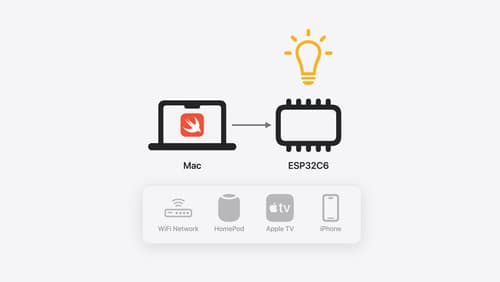i'd like to write some esp32 code in Swift
Asked on 2024-08-04
1 search
To write code for an ESP32 in Swift, you can use the new "Embedded Swift" feature introduced by Apple. Here are the key steps and resources you need to get started:
-
Setup: Ensure you have a working HomeKit setup, a Wi-Fi network, and some Apple devices connected to it. You'll need a programmable embedded device like the ESP32-C6 development board.
-
Tools: Use NeoVim and CMake for your development environment. The project will use a third-party SDK from your device vendor, which is typically written in C. You can use a bridging header to import the SDK's APIs into Swift.
-
Building and Flashing: Use the vendor-provided tools to build, flash, and monitor the device. This often involves running a Python script that handles the build and upload process.
-
Interoperability: Swift's interoperability allows you to call C APIs directly from Swift. This is useful for controlling hardware components like LEDs.
-
Abstractions: While you can call C APIs directly, it's better to build Swift wrappers and abstractions to write clean and ergonomic Swift code.
-
Resources: Refer to the Embedded Swift user manual for detailed instructions on getting started, compiler flags, and dependencies. Example projects on GitHub can serve as templates for your own projects.
For a detailed walkthrough, you can watch the session "Go small with Embedded Swift" starting at the "Getting started" chapter.
Relevant Sessions
Example Code Snippet
Here's a basic example of how you might set up an LED control in Swift:
import Foundation
// Assuming you have a bridging header to import the C SDK
// #import "VendorSDK.h"
class LEDController {
func setLEDColor(hue: Int, saturation: Int, brightness: Int) {
// Call the C API from the vendor's SDK
vendor_set_led_color(hue, saturation, brightness)
}
}
// Usage
let ledController = LEDController()
ledController.setLEDColor(hue: 240, saturation: 100, brightness: 80)
This example demonstrates how to call a C function from Swift to control an LED's color. You can build more complex abstractions and functionality as needed.
For more details, you can refer to the session "Go small with Embedded Swift" starting at the "Using Swift's interoperability to control the LED" chapter.

